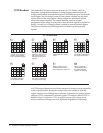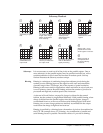
Chapter 3. Advanced CCD Theory 31
Classical CCD
Implementations
The one-dimensional charge transfer concept can be extended to two
dimensions. Buried channels arranged in parallel establish columns; charge
cannot migrate between columns. Along each column, charge is contained in
individual potential wells by a multiphase gate structure, as discussed for the
one-dimensional case. The result is a two-dimensional array of independent
potential wells.
A Typical CCD Imager shows a stylized CCD imager. The large square array is
the parallel register. In this example, the parallel register contains 262,144
independent potential wells, called picture elements or pixels. Each pixel is
20 µm square and contains a single charge packet.
Pixel columns
Parallel clocks
Serial clocks
10.25 mm
10.25 mm
20 µ
A Typical CCD Imager
20 µ
One
pixel
Serial Register 512 x 1 pixels
Output node
Parallel Register
512 x 512 pixels
The serial register is along one side of the parallel register, perpendicular to the
pixel columns. The serial register is itself a one-dimensional CCD. It may be
masked so that incident photons cannot create charge.
Many CCD formats and aspect ratios are available; the choice of CCD is dictated
by the application.
When a CCD imager is exposed to light, charge accumulates in the potential
wells of the parallel register. Charge can accumulate over an extended period of
time. The total amount of charge is proportional to the product of the light
intensity and the exposure time. (A charge accumulation is often called an
integration.) The complete charge pattern corresponds to the focused image.


















